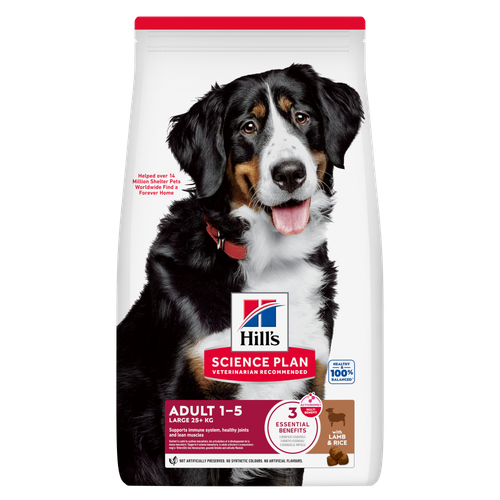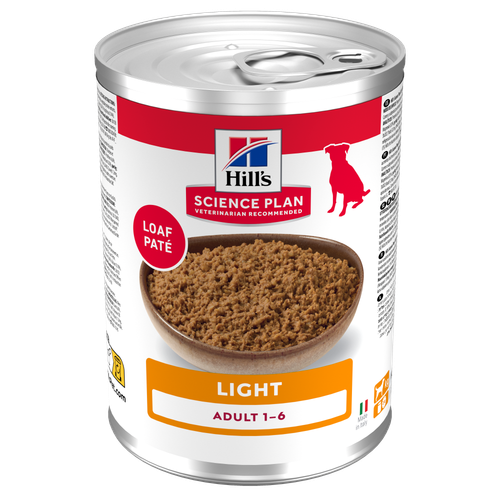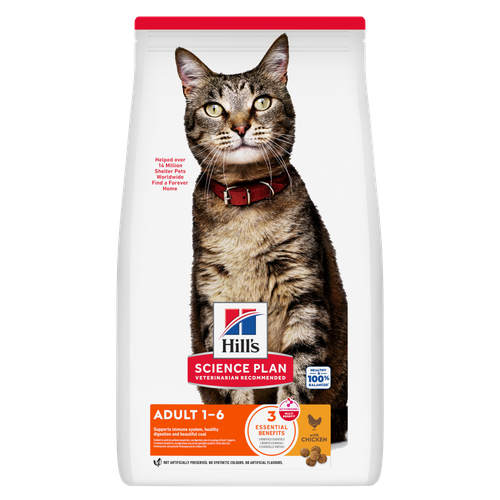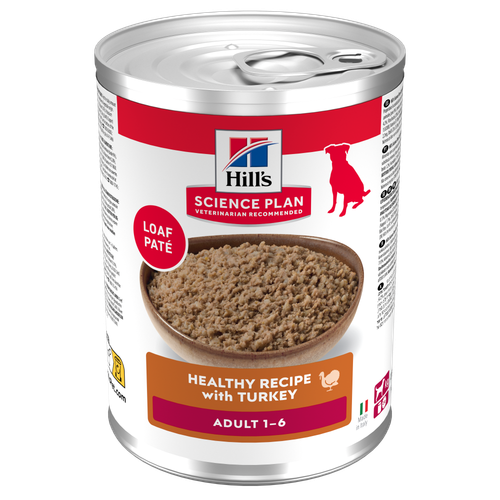
-
Find the right food for your petTake this quiz to see which food may be the best for your furry friend.Find the right food for your petTake this quiz to see which food may be the best for your furry friend.Featured products
 Large Breed Adult Dog Food
Large Breed Adult Dog FoodHill's Science Plan Large Breed Adult Dog Food with Lamb & Rice is a complete pet food, specially formulated with ActivBiome+ Multi-Benefit Technology.
This food is specifically designed to fuel the energy needs of large breed dogs during the prime of their life.Shop Now Adult Light Dog Food
Adult Light Dog FoodHill's Science Plan Light Adult Wet Dog Food is a complete premium pet food for adult dogs that tend to gain weight easily. This deliciously smooth loaf is formulated to deliver the appropriate amount of energy to support weight maintenance in adult dogs.
Shop Now Perfect Digestion Large Breed Puppy Food
Perfect Digestion Large Breed Puppy FoodPrecisely balanced nutrition with Hill's ActivBiome+ prebiotic blend actively contributes to supporting digestive health and overall wellbeing to help your pet feel their best
Shop NowFeatured products Adult Cat Food
Adult Cat FoodHill's Science Plan Adult Cat Food with Chicken is a complete pet food, specially formulated with ActivBiome+ Multi-Benefit Technology.
This food is specially formulated to fuel the energy needs of cats during the prime of their life.Shop Now CULINARY CREATIONS ADULT CAT FOOD
CULINARY CREATIONS ADULT CAT FOODHill's Science Plan CULINARY CREATIONS Adult cat food with Salmon & Carrots was formulated to provide a great-tasting experience to cats. Its delicious flavour and texture are combine with essential nutrients to support cats' optimal health during the prime time of their life. Specially formulated with high-quality salmon protein, essential taurine for heart health & balanced minerals to support kidneys & bladder.
Shop Now Sterilised Adult Cat Food
Sterilised Adult Cat FoodHill's Science Plan Adult Sterilised Cat Dry Food with Salmon is specially formulated with ActivBiome+ Multi-Benefit Technology. It is a precisely balanced nutrition, tailored to meet the needs of sterilised cats, to help keep sthem lean & healthy.
Shop Now -
Dog
- Dog Tips & Articles
-
Health Category
- Weight
- Food & Environmental Sensitivities
- Urinary
- Digestive
- Joint
- Kidney
-
Life Stage
- Puppy Nutrition
- Adult Nutrition
- Senior Nutrition
Cat- Cat Tips & Articles
-
Health Category
- Weight
- Skin & Food Sensitivities
- Urinary
- Digestive
- Kidney
-
Life Stage
- Kitten Nutrition
- Adult Nutrition
Featured articles The Incredible Science Behind Your Pet's Microbiome
The Incredible Science Behind Your Pet's MicrobiomeLearn what your pet's microbiome is, how it contributes to your pet's gut and overall health, and why nutrition is important in maintaining healthy microbiomes.
Read More Pet Nutrition: What Makes "Healthy" Pet Food Healthy? | Hill's Pet
Pet Nutrition: What Makes "Healthy" Pet Food Healthy? | Hill's PetIn people, the right diet is very important. If you are eating the wrong way for your metabolism, activity level, age and lifestyle you could end up with health issues.
Read More Microchipping: The Facts | Hill's Pet
Microchipping: The Facts | Hill's PetThe government has announced that as of April 2016, all dogs in the UK must be microchipped by law.
Read More -


Few things can be quite as frustrating to a dog owner as dog fleas. They can give painful bites and in some cases transmit disease. An infestation is irritating but manageable and with just a little work they can be treated and prevented.
What are they?
The first step to dealing with fleas is to make sure you understand them and their lifecycle. Fleas are small, flightless insects that survive on blood. They should be visible to the naked eye but if your dog has dark fur you may have an easier time seeing them against the skin. Otherwise, you have to hunt for them.
An irritant at every stage
A flea goes through four stages in its lifetime: egg, larvae, pupae and adult. Adult females lay eggs in batches of 20. These are laid on the host but are usually quick to fall to the ground. Eggs are very small, oval shaped and grey or white in colour.
Once the eggs hatch, larvae emerge which feed mostly on debris such as faeces, dead insects or vegetable matter. Within a week or two the larvae will spin cocoons and pupate for another one to two weeks. Adult fleas emerge and must immediately find a host for a source of blood.
Fleas tend to specialise in a particular kind of host. The type you'll find on your dog won't normally feed on humans but there are always exceptions.
Prevention
It is much better to prevent a flea infestation in the first place than to try and eliminate one later. Unfortunately it 's difficult to guess the source of a flea infestation until you've already had one.


Tasty Tips
Careful vacuuming with particular attention paid to nooks, crannies and upholstered furniture will go a long way towards getting rid of eggs, larvae and cocoons.
If you've never had fleas in your home before, the most likely way for them to get in is to be carried from outside by your dog.
If you know he has been infested after a trip to a certain location (a friend's house for example) then in future, you should bathe and comb him whenever he returns home from that particular place. Use a fine-toothed comb and keep soapy water on hand to drown the fleas.
If the outdoor source is as close as your front lawn then there's little you can do besides taking extra precautions during flea season.
Spotting the signs
You can tell if your dog has fleas when he is scratches or bites excessively or develops a rash on his skin, Eggs or flea dirt (dark, hard pellets of digested blood) either in his fur or on his bedding are also a good indicator.
Treatment
Your vet can recommend a number of treatments to help quickly eliminate fleas and their eggs. These usually work by killing adult fleas (and turning your pet into a walking flea death trap!) or by weakening larvae.
Because treatment usually only affects fleas in one of their life stages it is important to supplement any treatment with diligent cleaning of your dog's bedding.
Be wary of flea treatment products not provided by your vet. As ever, it is always wise to consult with your vet before beginning any sort of treatment on your animal.


One of our staff authors prepared this article for you
Related products

Hill's Science Plan Light Adult Wet Dog Food is a complete premium pet food for adult dogs that tend to gain weight easily. This deliciously smooth loaf is formulated to deliver the appropriate amount of energy to support weight maintenance in adult dogs.

Hill's Science Plan Adult Wet Dog Food with Turkey is a complete premium pet food for adult dogs from 1 year. This deliciously smooth minced turkey loaf is formulated to deliver the appropriate amount of energy to support the needs of adult dogs.

Precisely balanced nutrition with Hill's ActivBiome+ prebiotic blend actively contributes to supporting digestive health and overall wellbeing to help your pet feel their best

Hill's Science Plan Large Breed Adult Dog Food with Lamb & Rice is a complete pet food, specially formulated with ActivBiome+ Multi-Benefit Technology.
This food is specifically designed to fuel the energy needs of large breed dogs during the prime of their life.
Related articles
Discover the causes, signs, and treatments of kidney disease in dogs and find methods of supporting your dog's kidney health. Learn more at Hill's Pet.

Dog obesity is a significant problem - learn more about helping your dog become trimmer and healthier through improved nutrition.

Gurgling tummies in turmoil are not good news for pets. Owners who have to clean up the unfortunate consequences, digestive problems are one of the rare downsides to owning a pet.

Learn to see the signs of an upset stomach in your dog, understand the triggers and explore some possible solutions.

Put your dog on a diet without them knowing
Our low calorie formula helps you control your dog's weight. It's packed with high-quality protein for building lean muscles, and made with purposeful ingredients for a flavourful, nutritious meal. Clinically proven antioxidants, Vitamin C+E, help promote a healthy immune system.
Put your dog on a diet without them knowing
Our low calorie formula helps you control your dog's weight. It's packed with high-quality protein for building lean muscles, and made with purposeful ingredients for a flavourful, nutritious meal. Clinically proven antioxidants, Vitamin C+E, help promote a healthy immune system.

